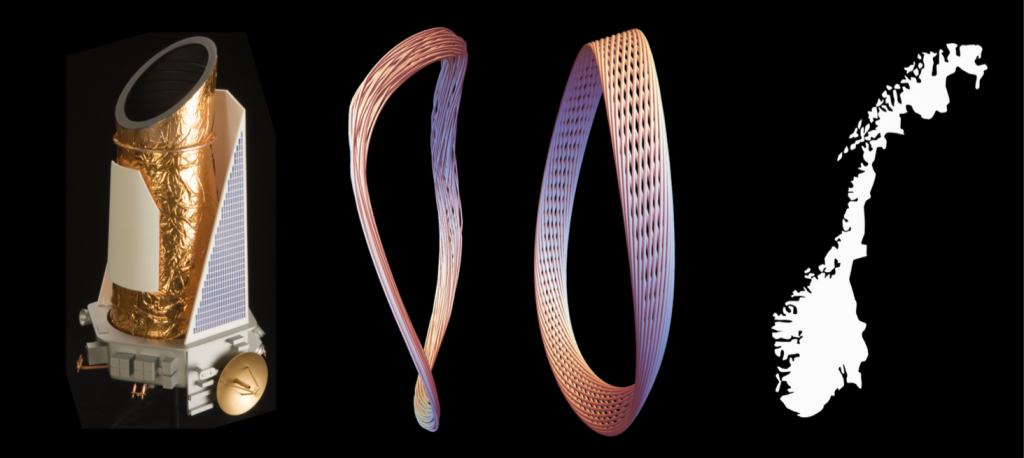On the second day of my University of Hawai’i sabbatical, I began to work with space telescope data that would invigorate the study of variable stars and justify my NASA T-shirts.
While the brightness of stars like the sun is nearly constant, the brightness of other stars changes with time. Exploiting the unprecedented capabilities of the planet-hunting Kepler space telescope, which stared at 150 000 stars for four years, my colleagues and I discovered evidence that certain stars dim and brighten in complex patterns with fractal features. Such stars pulsate at primary and secondary frequencies whose ratios are near the famous golden mean, the most irrational number. A nonlinear system driven by an irrational ratio of frequencies is generically attracted toward a “strange” behavior that is geometrically fractal without displaying the “butterfly effect” of chaos. Strange nonchaotic attractors have been observed in laboratory experiments and may be useful in describing brain activity and climate, but a bluish white star 16 000 light years from Earth in the constellation Lyra may manifest, in the scale-free distribution of its frequency components, the first strange nonchaotic attractor observed in the wild. The recognition of stellar strange nonchaotic dynamics may improve the classification of these stars and refine the physical modeling of their interiors.
We sampled the KIC 5520878 light curve at its primary period and decomposed the resulting time series into sine waves of different amplitudes and frequencies. The number of amplitudes varied with a negative power of the detection threshold. Specifically, if the threshold increased four-fold the number decreased eight-fold, for a wide range of thresholds. Similarly, in a famous example of spatial scaling, the length of the rugged, fractal Norwegian coast depends on the length of the measuring stick. In fact, the measured coast length decreases with increasing stick length, just like our frequency amplitudes: if the stick length increases four-fold, the measured coast length decreases eight-fold, for a wide range of stick lengths.

Using stellar luminosity data from the Kepler spacecraft (left), we reconstructed a star’s dynamical attractor (left center), modeled it phenomenologically (right center), and found that the spectral scaling of the star’s secondary frequencies is similar to the spatial scaling of the coast of Norway (right).
Fractal self-similarity can describe processes in time as well as patterns in space, and a music analogy elucidates our analysis of the variable starlight: From the stellar pulsation, we removed the backbeat to discover a subtle melody.
My colleague John Learned and others had earlier proposed that sufficiently advanced extra-terrestrial civilizations may “tickle” variable stars with neutrino beams to jog their otherwise very regular expansions and contractions and thereby transmit information throughout the galaxy and beyond. A team including many of us tested this hypothesis on the Kepler’s space telescope’s unprecedented photometric data for star KIC 5520878. Although we found some oddities in the KIC 5520878 light curve, we ultimately concluded that they are likely of natural origin. Nevertheless, we encourage testing of archival and future time series photometry for evidence of artificially modulated variable stars. Bill Ditto subsequently recognized the possibility of strange nonchaotic behavior in KIC 5520878 based on his 1990 experience obtaining the first laboratory observation of such behavior in a magnetoelastic ribbon experiment. We subsequently applied the diagnostic analysis used on the ribbon to the star.
We are currently creating phenomenological models of strange nonchaotic stars and are attempting to expand our results to multi-frequency variable stars outside the Kepler database. Can we connect their frequency ratios to the golden ratio or to the distribution of other hard-to-approximate irrational frequency ratios? Some natural dynamical patterns result from universal features that are common to even simple models. However, other patterns are peculiar to particular physical details. We don’t yet know if the frequency distribution of all variable stars is universal or particular. We are currently organizing an international conference for August to explore these issues.

One response to “Strange Nonchaotic Stars”
Well, to modify stars with neutron “infusion” these extraterrestrials would need neutrino sources of incredible dimensions (and energy consumption) for all of what we currently know of neutrino “creation” as such. But your article makes me wonder about something else: while we are finding more and more exoplanets that might orbit their “suns” at distances (relative to their suns’ radiative power) that would allow for life to exist, I now wonder if these actually are getting enough stable “lighting” from these stars. In other words: we now know, thanks to the debate between several factions among climate researchers fighting over “man-made” versus solar causes driving climate change, that there are relatively small changes that drive earth’s climate cycles such as ice ages or the Maunder minimum etc. And we by now know that were these solar fluctuation only a little greater then life as we know it on earth might not have evolved. If that were so then this begs the question if such pulsating is more frequent and if that further reduces the chances of extraterrestrial life to be detected any time soon, i.e. maybe even though there are now more planets than we previously thought, maybe their stars in general are too fluctuating to allow for stable enough conditions?